Are you looking to buy a Honda CRF250R but aren’t sure if it’s the right dirt bike for you? Whether you’re buying your first dirt bike, looking for a cheap trail bike, or want to upgrade, you’re in the right place!
In this review, you’ll learn:
- What kind of dirt bike the Honda CRF 250R is
- How it compares to other 250cc dirt bikes from Honda
- Why it may or may not be good for you
- What to expect when buying and riding one so that you save time & money researching
What is the Honda CRF250R?
It’s a 250cc 4-stroke motocross bike that Honda has been making since 2004, but it’s changed many times. It’s always had a high-performance liquid-cooled engine, although the engine, fuel system, suspension, and starting system are some of the big updates over the years.
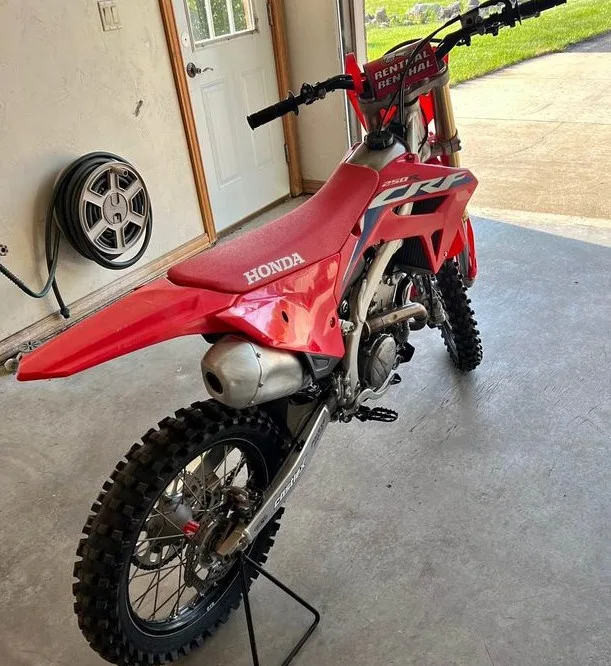
Who's it for?
Being a full-size motocross bike, it’s made for adults or older teens that want to race on a motocross track. It’s definitely not a beginner-friendly dirt bike - if you’re looking for your first dirt bike, you must check out the CRF250F trail bike.
While the CRF250R can be trail ridden, it’s much harder to ride in the woods or if you’re just getting back into dirt biking after a long break because of its aggressive nature - keep reading to learn more.
Engine - trail vs race engine
It’s a 250 cc liquid-cooled 4-stroke engine with a 5-speed manual clutch transmission, but what does that mean for you? The biggest difference between the CRF250R engine and a trail bike engine, such as the CRF250F, is that the 250R has way more power, but that’s only part of it.

The CRF250R is made for top-end horsepower, which means it has very little low-end torque right off of idle, but lots of snappy power when you rev it up high in the RPM range.
This makes it hard to control if you’re a new rider or trail riding in a tight and technical section. However, the massive power at high RPM is perfect for racing on a motocross track because it will accelerate very quickly if you have traction.
Close vs wide ratio gearing
The CRF 250R has a 5-speed close-ratio transmission, which simply means that the gears are closer together. So when you are accelerating and shifting up a gear, the RPM won’t drop off very much, allowing you to stay in the “meat” of the power and keep accelerating quickly.
This is great for racing compared to a “wide ratio” trail bike tranny because the power won’t drop off as much.
The drawbacks? It requires more frequent shifting, 1st gear is taller, and 5th gear is shorter, so you have to compromise your acceleration vs top speed if you’re trail riding.
Carb vs EFI
In 2004, The Keihin FCR flat slide pumper carb was modern tech because it gave more peak power without bogging as much, but it’s outdated now. Honda, along with most other dirt bike companies, updated the CRF250R fuel system to electronic fuel injection in 2010 - some complained about complexity, but it was for the better.
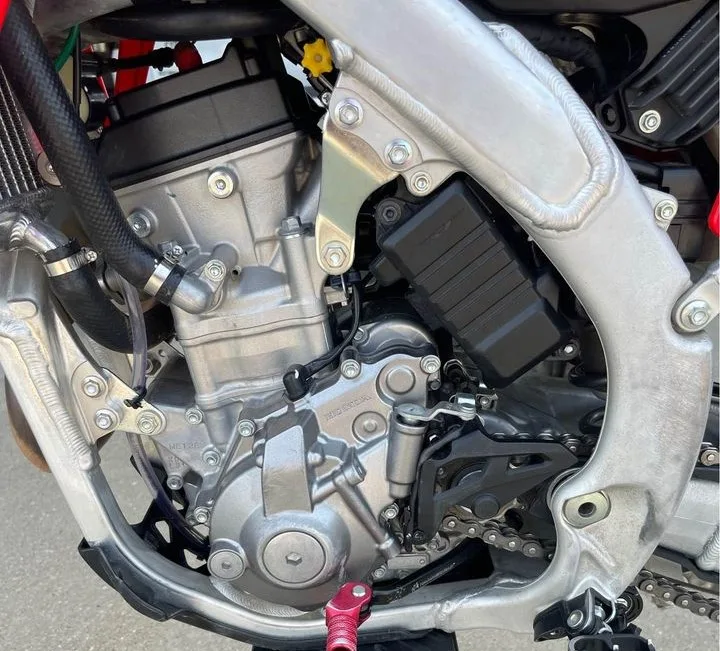
When comparing fuel injection to a carb, the peak power may not be quite as good as a properly tuned carburetor, but it’s better everywhere else. Starting is easier, better throttle response everywhere, and no more dealing with messy jets (after tearing half your bike apart just to remove the carb!).
The 2009 and older 250R is still a pretty good 250F MX bike, but if you don’t want to re-jet or ride at different elevations, EFI might be worth spending a little more for.
Kick start vs Electric start
Simplicity and weight are two big factors in modern race bikes, which is why it took so long for Honda to add an electric start to the CRF250R (first year was 2018). “It adds too much weight” and “I need a backup kick starter” were the biggest objections, but I don’t see anyone complaining these days with virtually every motocross bike having the magic E-start button.
What makes E-start better even with the added weight?
Why? Because it’s convenient and less exhausting when you can just push a button and go! The 2017 and older kickstart models are still great and fairly easy to start, but there are a few tricks to getting them started right away - especially when the engine is hot! One trick for any bike (e-start or not), is starting it in neutral - there’s less drag on the engine, so it turns over better.
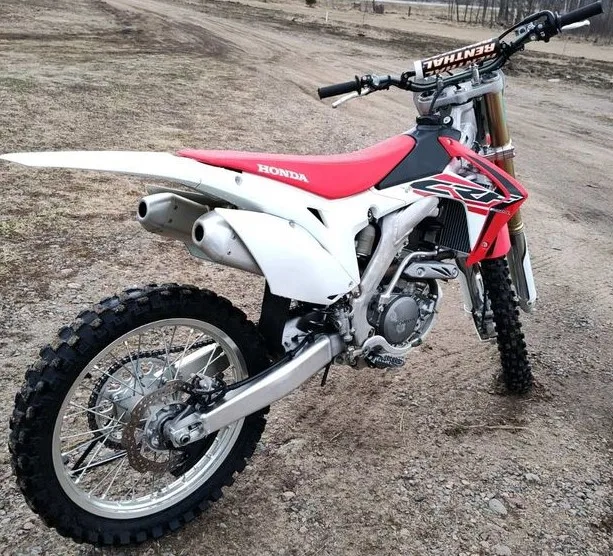
Horsepower - the #’s LIE
Surprisingly, the peak power hasn’t changed much in about 20 years - the CRF250R still has about 38 horsepower, but that’s only a fraction of the story. You see, peak horsepower is just one number at one specific RPM.
So, if you drop just 500 RPM, it could potentially be a lot less power. What I mean to say is - you want “usable power”, and not just a “dyno number” that everyone seems to crave.
So, over the years, Honda has improved the torque and horsepower at virtually every RPM below that peak HP number. This means that it’s easier to ride and race faster because it will still accelerate at a lower RPM, allowing you to stay in the same gear longer and not get exhausted as quickly.
Top speed - are you going for a land speed record?
The max speed of a stock Honda CRF250R is about 70 MPH, but does that really matter? Nope - not unless you’re drag racing or going for a land speed record.
You can, of course, change the theoretical top speed, which will also affect the acceleration. For more speed and less acceleration, you can go to a smaller rear sprocket (Amazon).
Suspension
When it comes to performance, the CRF250R motocross bike suspension is as high-performance and high-tech as it gets - this is great, but not if you’re a beginner!
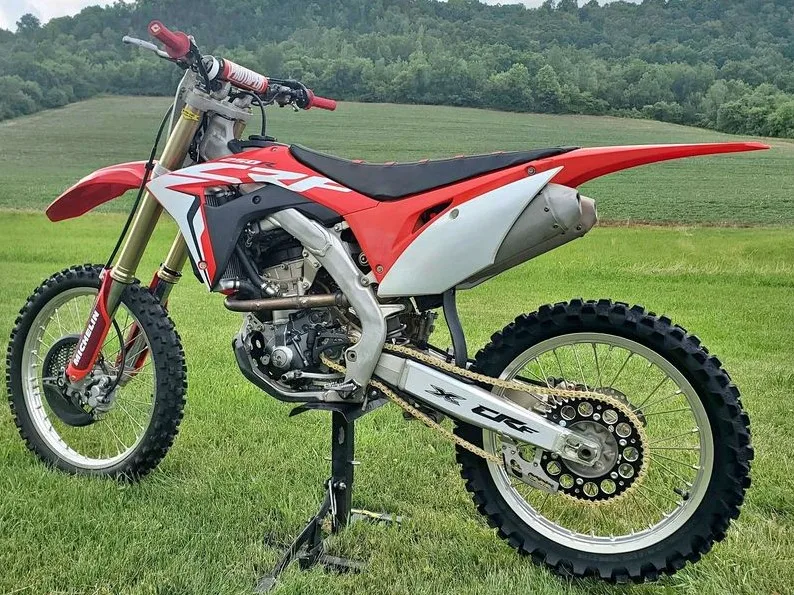
Why? Because the forks and shock are stiff for doing big jumps at high speeds, and the fork seals are more likely to leak because dirt can get stuck in them more easily than conventional trail bike forks.
With that said, let’s break down what you’ll get with the CRF250R suspension and what you can expect it to feel like when riding and tuning it - there are many things to adjust for more comfort and performance, which will give you more confidence and faster lap times!
Front forks
The stock forks are fully adjustable, but that doesn’t mean they will work for anyone. A stock CRF 250R is made for 160-180 pound riders, but it can work if you’re slightly lighter or heavier.
If you don’t have the right spring rates in the forks, that’s the first thing to do or else they won’t work well. For example, if you’re too heavy, you’re going to be sitting too low in the stroke, making it feel harsh, and then it’s also going to bottom out (fully compress) easily, making it harsh and potentially dangerous to ride.
What to do if you have the right springs
After that, you can adjust the compression and rebound damping clickers. This will slow down or speed up how quickly the forks compress and rebound when hitting jumps, bumps, and whoops on the track. The goal is the get the most traction by keeping the tires on the ground as much as possible.
Rear shock
The stock rear shock is even more important when it comes to getting it set up right for your weight & riding style. It comes well balanced with the forks, which means it’s stiff for big obstacles, but you still need the right spring rate and then set the sag.
When you get the right amount of rider sag (ride height), the front and rear suspension will be balanced so that you have the most control.
For example, if the rear is too low (spring is too soft or not enough shock preload), this will give you the “choppered out” effect, which gives you a little more stability at high speed, but it’s harder to turn at low speed and the front end will slide out more easily because there’s not enough weight on it.
Handling
Like most 250F motocross bikes, the Honda CRF250R is a good-handling dirt bike because it’s lightweight and made to turn well. It may not be much lighter than a 450, but it will handle noticeably better and you won’t get exhausted as quickly.
Not only is the actual weight allowing you to lean and handle the bike with less effort, but the smaller engine has less rotating mass, which makes it feel lighter than a dirt bike with a bigger engine - that’s why it’s easy to get fatigued on a bigger bike, which can lead to crashing because your arms are tired and can’t hang on.
Weight - how it’s changed over the years
The latest Honda CRF250R weighs 229 lbs - this is the curb weight, which means it has all of the fluids and gas that you need to ride (realistic compared to ‘dry weight’ numbers). The 2004 CRF250R was about 223 lbs, which doesn’t seem right - why has Honda made it heavier when it’s supposed to be getting lighter as technology advances??
If you add in the extra weight of the fuel injection system (added in 2010), plus the electric starting system and battery (in 2018), and it’s only 6 lbs heavier than the old carb and kickstart model, that’s pretty good actually!
In fact, the 2018 model weighed 238 lbs, which shows that Honda reduced the weight by almost 10 lbs since adding the electric starter - that’s impressive on a motocross bike!
Seat height - what size rider is the CRF250R for?
With a seat height of 37.8 inches, the Honda CRF 250R is very similar to every other full size motocross bikes. It’s a comfortable size dirt bike if you’re 5’10”-6’2”, but it also depends on your inseam length.
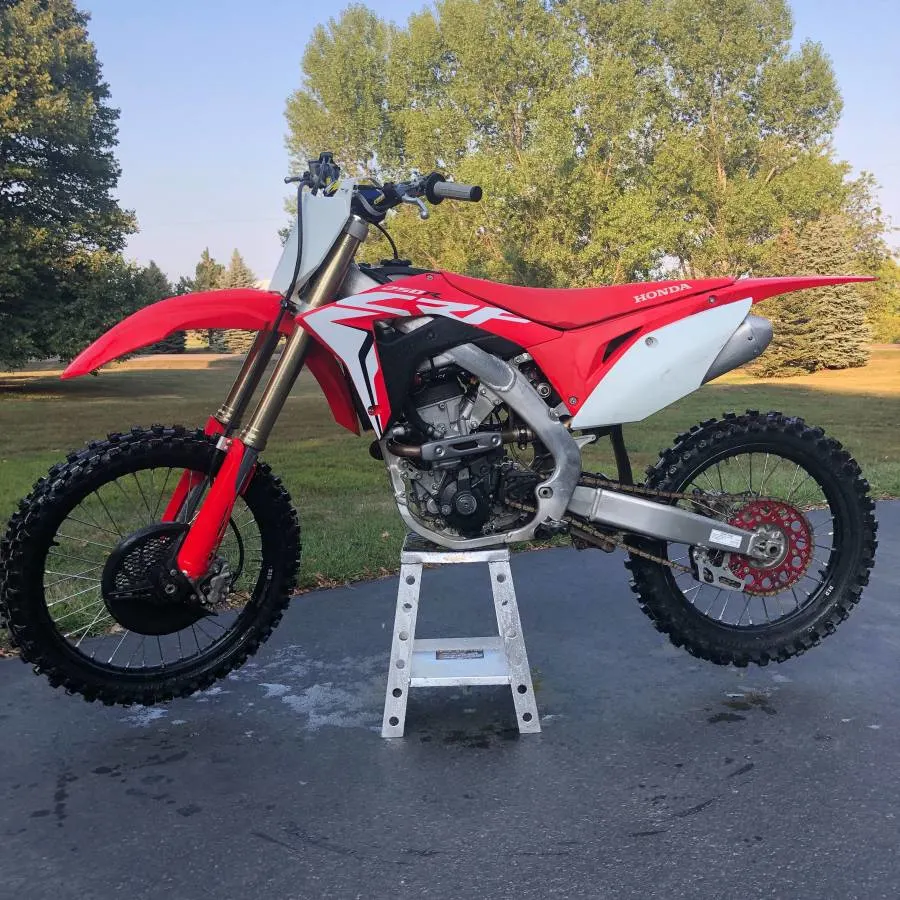
If you’re short, you’re probably asking “Why are dirt bikes so tall??” That’s because of the long travel suspension and ground clearance needed for optimum performance. At least there are some ways to lower the seat height.
But if you’re taller than average, then you’ll need to adapt to any motocross bike with proper technique or with some tall rider mods - but these can negatively affect your riding if not done right.
Model year history & changes
There have been so many changes over the years, but I don’t want a huge list of all the little things that don’t make much difference.
So, this is all of the major updates to the Honda CRF250R from ‘04 to currently:
- 2004: First year of the Honda CRF250R
- 2005: Updated cylinder head, cam, and mapping for better torque, as well as upgraded clutch & trans parts
- 2006: Updated to dual exhaust/muffler
- 2007: Updated cylinder head, exhaust, and trans for better power & shifting
- 2010: First year of fuel injection, updated to a single exhaust muffler
- 2012: Updated cylinder head & throttle body for a broader power curve (more torque)
- 2015: Updated to air forks
- 2018: First year of electric start, new DOHC engine (vs older Unicam-style engine) - more HP and less low-end torque
- 2022: Updated engine with improved low to midrange torque
Reliability - how long will it last?
Most people think that a 250F motocross bike is not reliable, but that’s not always the case. In fact, most Honda CRF250R’s are just as reliable, if not more so, than any other brand MX bike.
As long as you take care of it and don’t constantly bounce it off the rev limiter, it can last quite a while. How long, you ask? Well, an expert racer may need to rebuild the top end every 20 hours, but if you’re just a casual novice racer, you could get up to 100 hours or more with proper maintenance.
Any common issues?
The most common issue or complaint about the CRF250R was the first couple of years with the valvetrain. If you didn’t keep the air filter clean or change the oil, you’re much more likely to burn up the valves. Honda upgraded the metal quality in 2006, which seemed to solve any common problems.
Other than that, there aren’t any major issues if you’re properly taking care of it. For example, if you “forget” to check the oil every ride, it may leave you stranded with a blown engine.
CRF250R Specs & dimensions
These are the specs of the current CRF 250R from Honda’s website:
| CRF250R | |
| Manufacturer | Honda |
| Engine | 249cc liquid-cooled 4 stroke |
| Transmission | 5-speed close-ratio manual clutch |
| Seat Height | 37.8” (96cm) |
| Suspension Travel | 12.2”/12.3” |
| Weight | 229 lbs |
| Horsepower | 38 HP |
| Top Speed | 70 MPH |
| Price (New MSRP) | $8,299 |
Is the CRF250R the right dirt bike for you?
Still can’t decide if you should get one? Whether you’re considering “settling” for a motocross bike because you can’t find a cheap trail bike, or you just want to know if it’s the right size, here are some practical pros & cons:
Pros:
- Has plenty of power for 99% of racers
- Less frequent rebuilds than a 125 2-stroke if properly taken care of
- Lightweight and less exhausting than a 450F MX bike
- 2010+ has EFI
- 2018+ has an electric start
- Honda holds its value when
- Good size MX bike if you’re an adult that’s new to racing
- No mixing gas
Cons:
- It’s NOT a good beginner bike due to snappy power and stiff suspension
- Not a good trail bike due to the reasons above
- Higher chance of buying a “ticking time bomb” if the previous owner didn’t maintain it well
- Rebuilds can be very costly - especially if you’re paying a shop to do the work
- Not nearly as much low-end torque as a 450
How much does the CRF 250R cost?
The MSRP of a new CRF250R is $8,299, but then they tack on other charges, such as a $400 “Destination” and $100 “Freight” surcharge. Not to mention taxes and any other fees, making the OTD price considerably higher than the retail price. It’s sneaky just to get the “sticker price” cheaper, but basically, every brand is doing it now to make up for higher production costs.
Used bikes are cheaper
In the used market, you can save thousands on one that’s a few years old. MX bikes are usually cheaper than trail or enduro bikes because there isn’t as high of a demand.
You could get a 5-year-old CRF250R for around 4000-5000 dollars, but it also depends on your location and the condition of the bike.
CRF250R vs CRF250F
Even though they’re both 250cc 4-stroke dirt bikes, they’re very different in almost every way. The 250R is a motocross bike with almost twice as much power, stiffer suspension, and a tall seat height in comparison to the 250F trail bike.
CRF250R vs CRF250RX
A much closer comparison, but the main difference is that the 250R is an MX bike with stiffer suspension, while the 250RX is an enduro bike with slightly softer suspension and power curve, making it more enjoyable for off-road riding or racing.
CRF250R vs CRF250X
The big difference is that the CRF250X is an older enduro bike with softer suspension and a detuned engine for smoother and more predictable power. It’s based on the first 250R engine but has an electric start and is much quieter - the 250X was discontinued in 2018.
Can the CRF250R be trail ridden?
Short answer? Yes, but it’s one of the worst choices you can make, especially if you’re a new or returning rider after a long break. It's snappy power and stiff suspension make it more exhausting and harder to ride.
You can try a bunch of mods to make it more “woods friendly”, but you’re better off starting on a beginner-friendly trail bike and learning how to ride it with control rather than depending on the extra power of the MX engine.
Learn how to trail ride with confidence
If you’re a casual trail rider, then I want to help you build your confidence quickly. Most people try to figure out how to ride a dirt bike on their own, but this will cause you to form bad habits that cause you to get exhausted quickly and lose control. I put together a quick guide of the basic techniques you need to ride with control - get it here today for FREE.

